Ethiopia’s Extraordinary Wildlife Tour Report 2020
7 July 2020


















































































































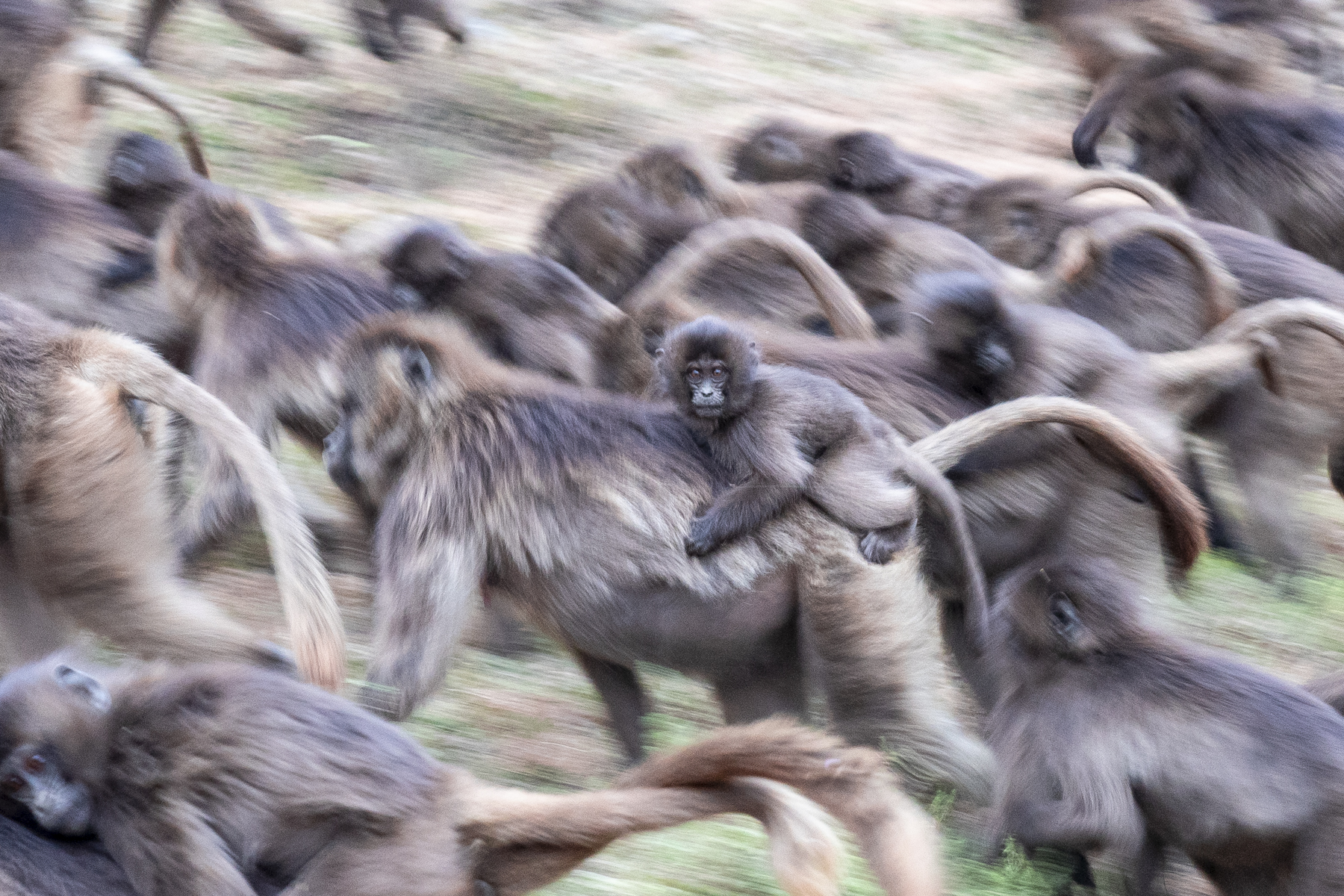
Night is coming, we must head for the cliffs! Gelada motion blur, all but one... (image by Mark Beaman)
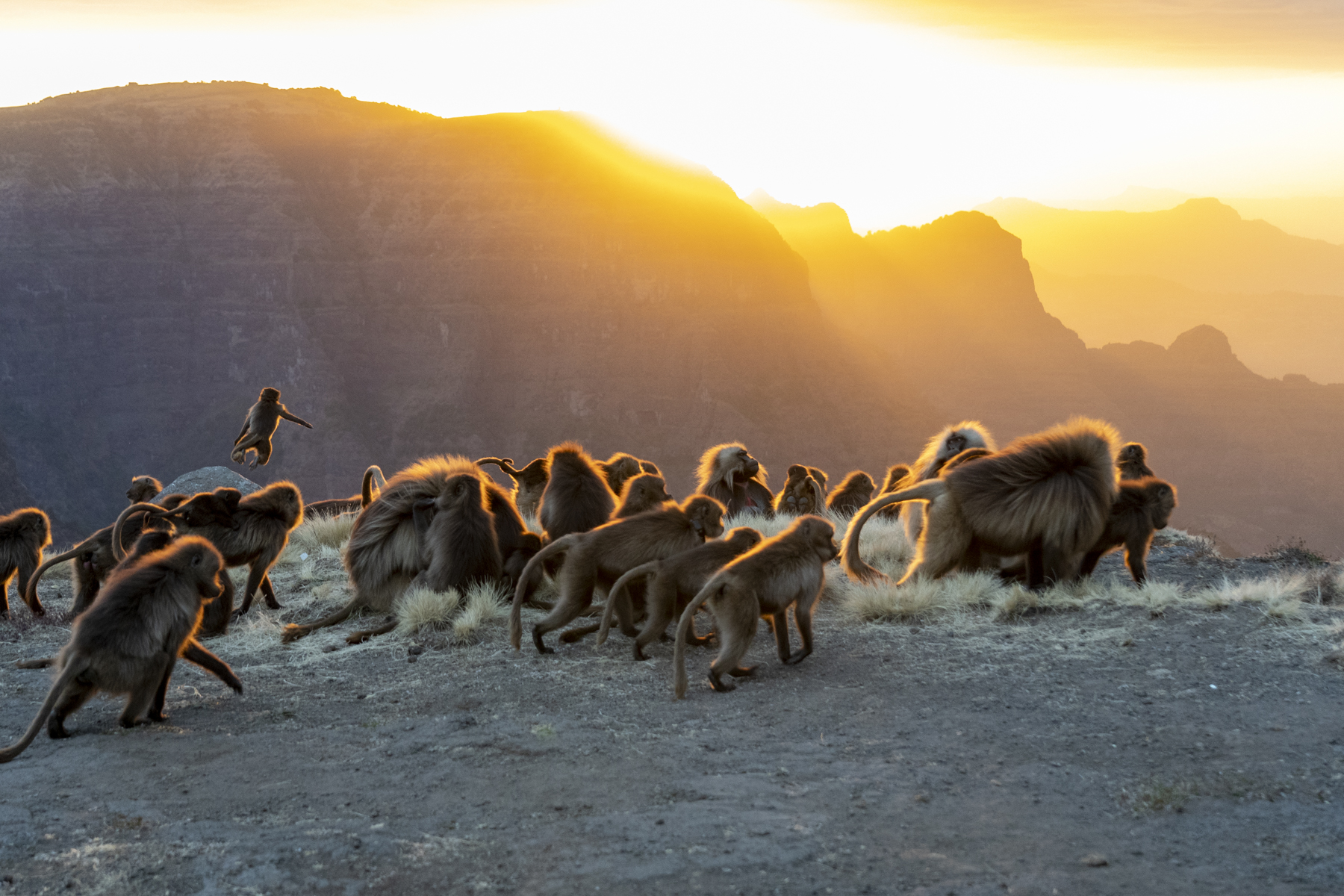
Geladas at sunset. There is still a chance to groom or play... (image by Mark Beaman)
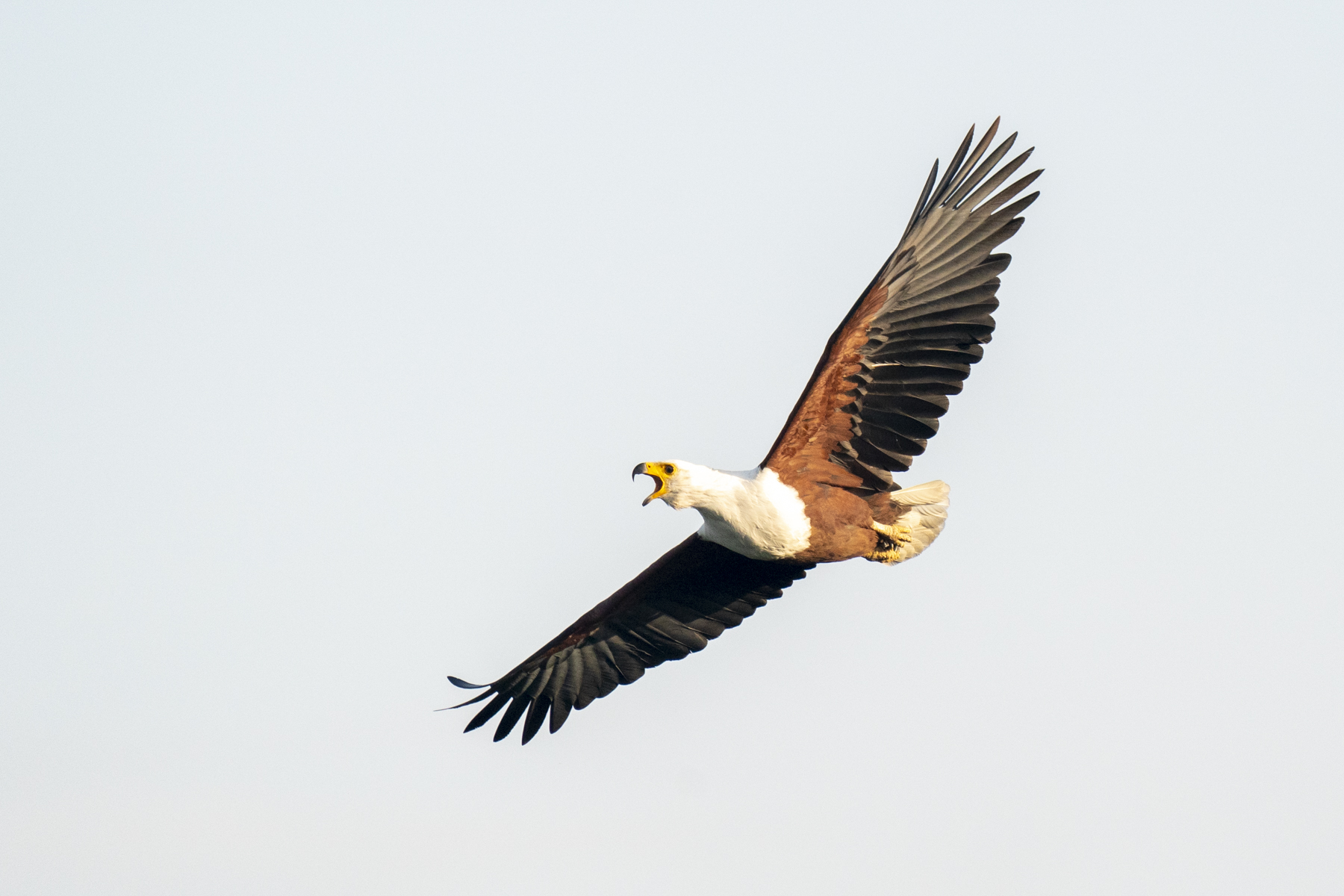
The evocative cry of the African Fish Eagle is one of the charismatic sounds of Africa (image by Mark Beaman)

Grivet Monkey portrait (image by Mark Beaman)

A Guereza Colobus challenges a rival (image by Mark Beaman)

'Horsepeckers': four Red-billed Oxpeckers change host for a while (image by Mark Beaman)

It's mine! Great White Pelicans at Lake Awassa (image by Mark Beaman)

Gelada portrait (image by Mark Beaman)

A huge Wahlia Ibex male gets up after a rest (image by Mark Beaman)
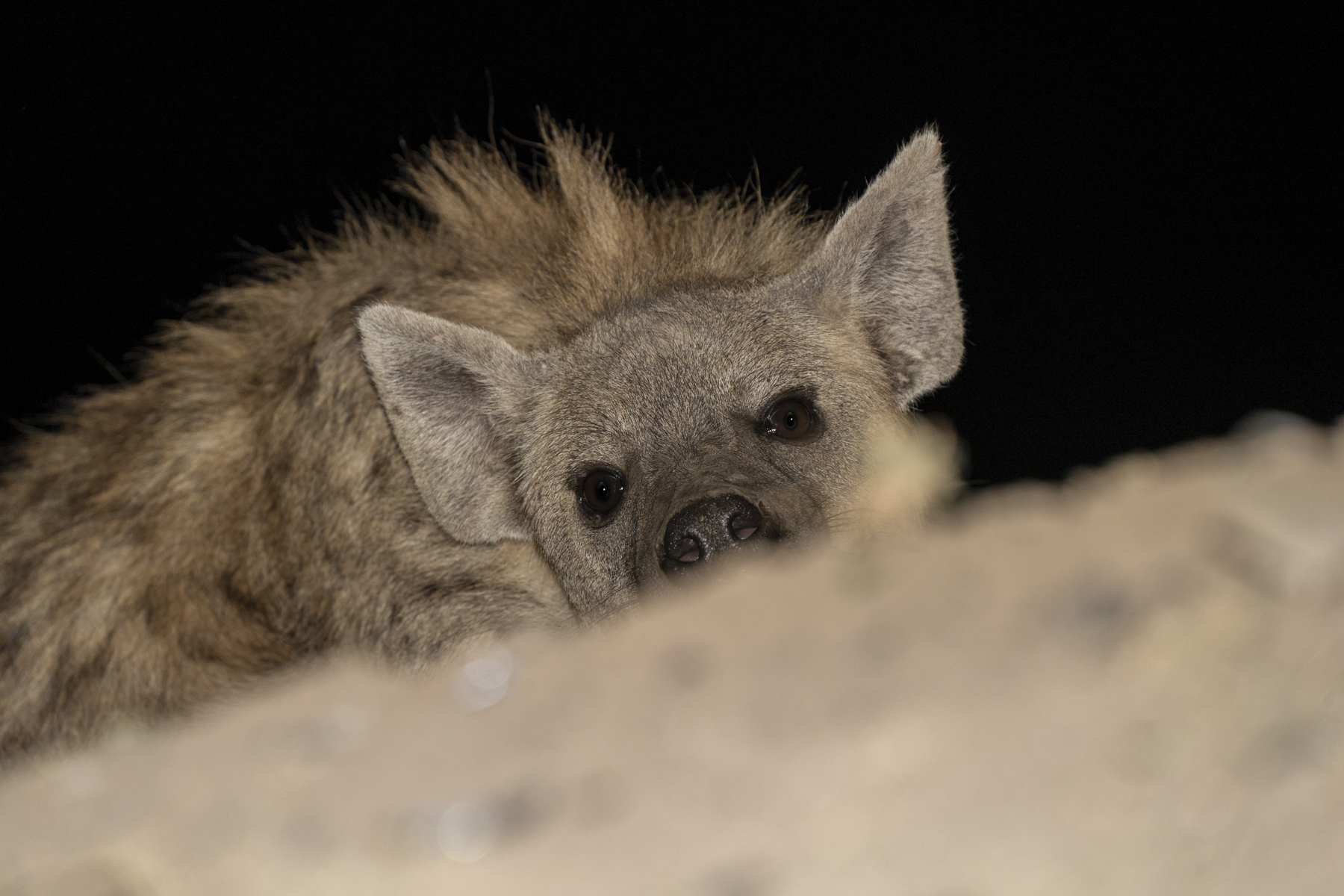
A lurking Spotted Hyena (image by Mark Beaman)

A pair of Tawny Eagles (image by Mark Beaman)

The thinker... (image by Mark Beaman)

Harar woman (image by Mark Beaman)

Marico Sunbird (image by Mark Beaman)

Thick-billed Ravens are very sociable birds (image by Mark Beaman)

The lovely Rosy-patched Bushshrike, a bird of arid habitats (image by Mark Beaman)

Bearded Vulture or Lammergeier (image by Mark Beaman)

Secretarybird (image by Mark Beaman)

A forest of camel legs (image by Mark Beaman)

An Ethiopian Wolf in rodent stalking mode (image by Mark Beaman)

Fortune favours the bold! Why wait? A Marabou leaps and gets its fish (image by Mark Beaman)

Harar lane (image by Mark Beaman)

African Pygmy Goose (image by Mark Beaman)

The endangered and fast-vanishing Arabian Bustard (image by Mark Beaman)

The ancient city of Harar, Ethiopia (image by Mark Beaman)

Hamadryas or Sacred Baboon (image by Mark Beaman)

Every little counts when you are hoping to get the fish first. Marabou Storks at Awassa Fish Market (image by Mark Beaman)

Gelada portrait (image by Mark Beaman)

Harar girl and her cat (image by Mark Beaman)

A Northern Carmine Bee-eater rides an Arabian Bustard. The bee-eater gets the flushed insects and perhaps the bustard gets a sharp-eyed lookout (image by Mark Beaman)

Abyssinian Owl; not the greatest photo but this is a rare and seldom-seen creature (image by Mark Beaman)

Spotted Hyena portrait (image by Mark Beaman)
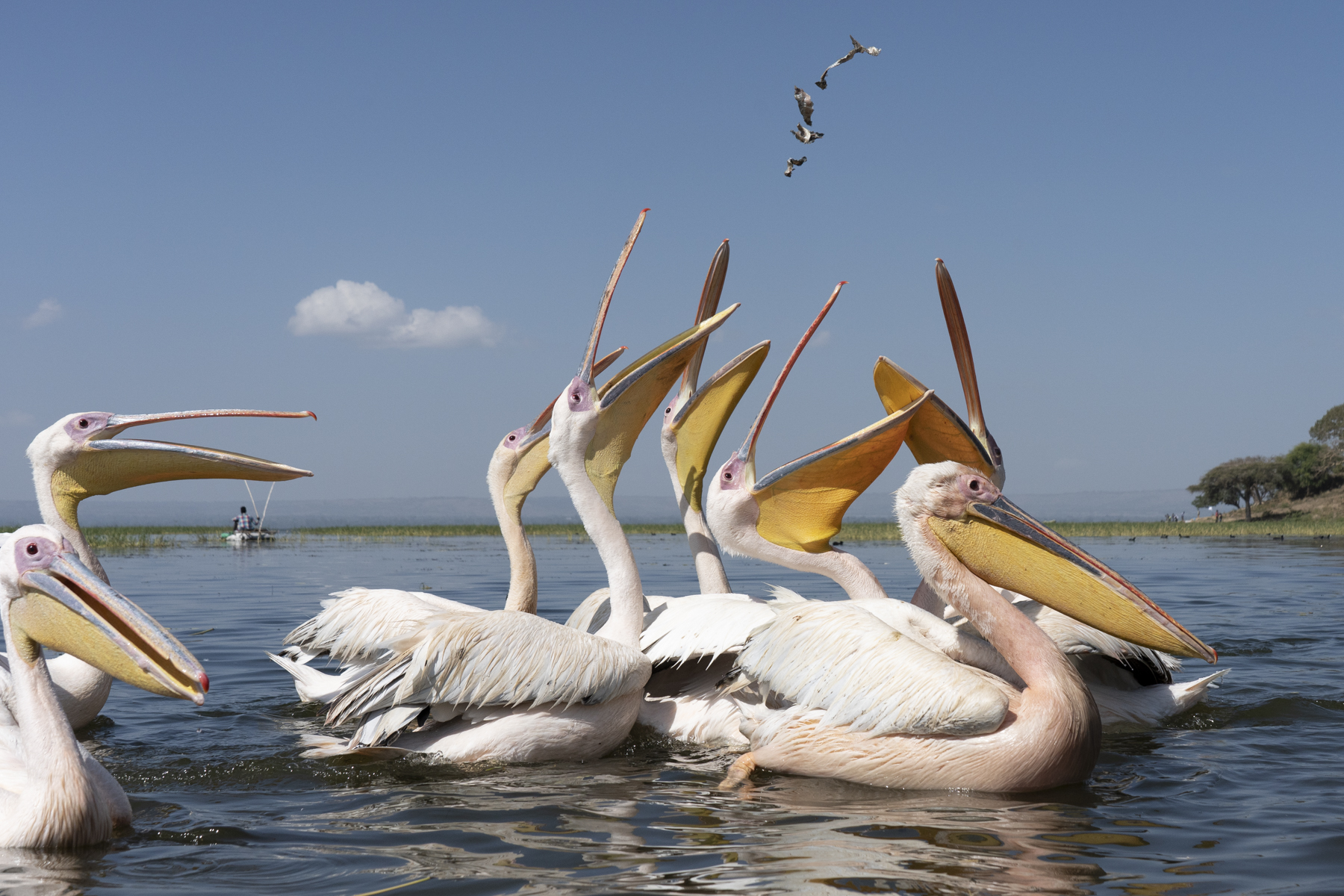
Here comes breakfast! Great White Pelicans at Lake Awassa (image by Mark Beaman)

Male and female Mountain Nyalas, endemic to the Ethiopian Highlands (image by Mark Beaman)

Harar woman (image by Mark Beaman)

The Simien escarpment at dawn (image by Mark Beaman)

There is an awful lot of room in a pelicans bill-pouch... Great White Pelicans at Awassa (image by Mark Beaman)

Wattled Ibises (image by Mark Beaman)

A Beisa Oryx in the dry bush country south of the Danakil Depression (image by Mark Beaman)

Geladas are very willing to try all kinds of foods (image by Mark Beaman)

A pair of endemic Rouget's Rails survey their domain (image by Mark Beaman)

Early morning in the Bale Mountains of Ethiopia (image by Mark Beaman)

An Ethiopian Wolf wanders across the vast landscape of the Bale Mountains (image by Mark Beaman)
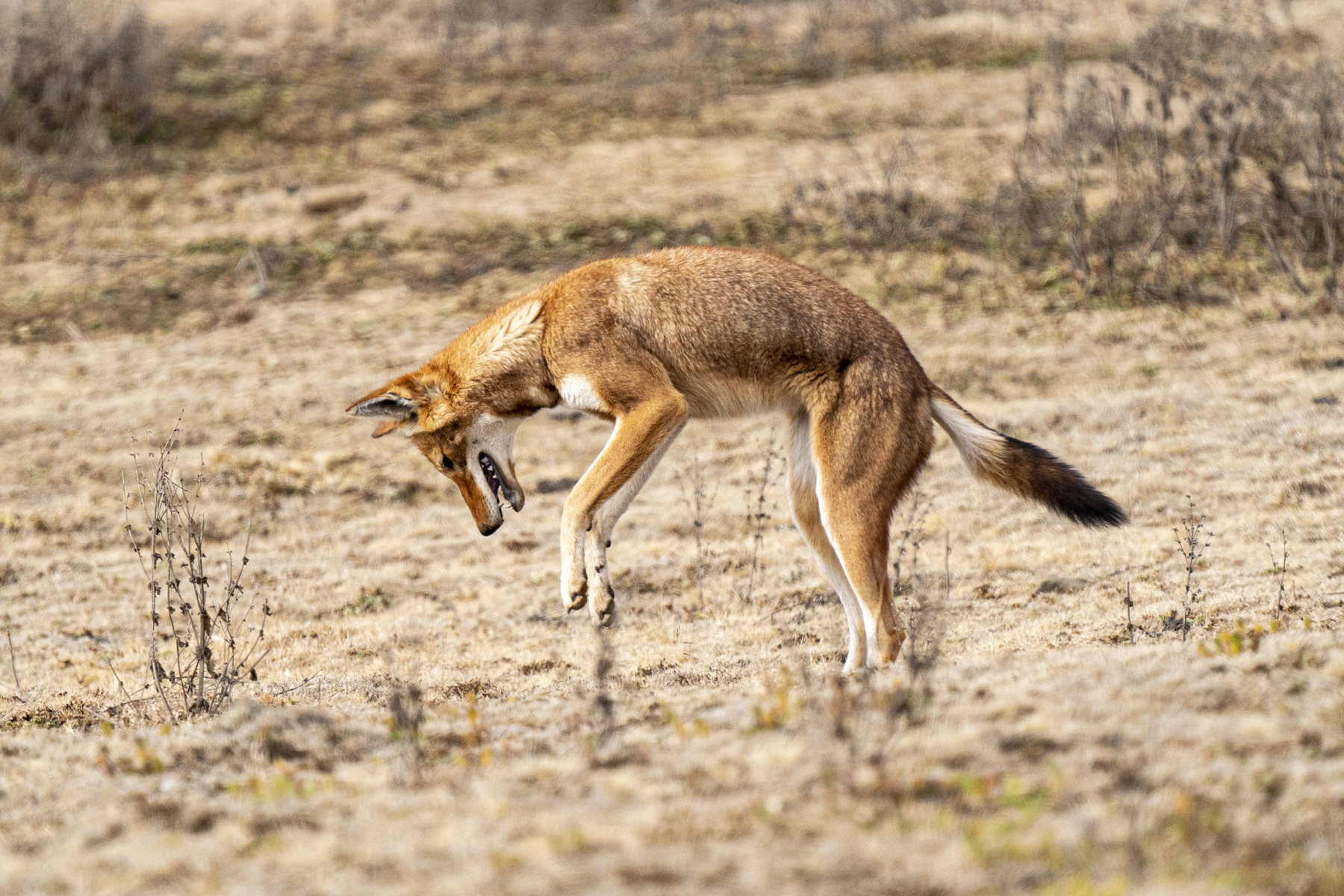
An Ethiopian Wolf pounces on its prey (image by Mark Beaman)

Look at those beds! So much better than a cold cliff, and no Leopards to worry about either... (image by Mark Beaman)
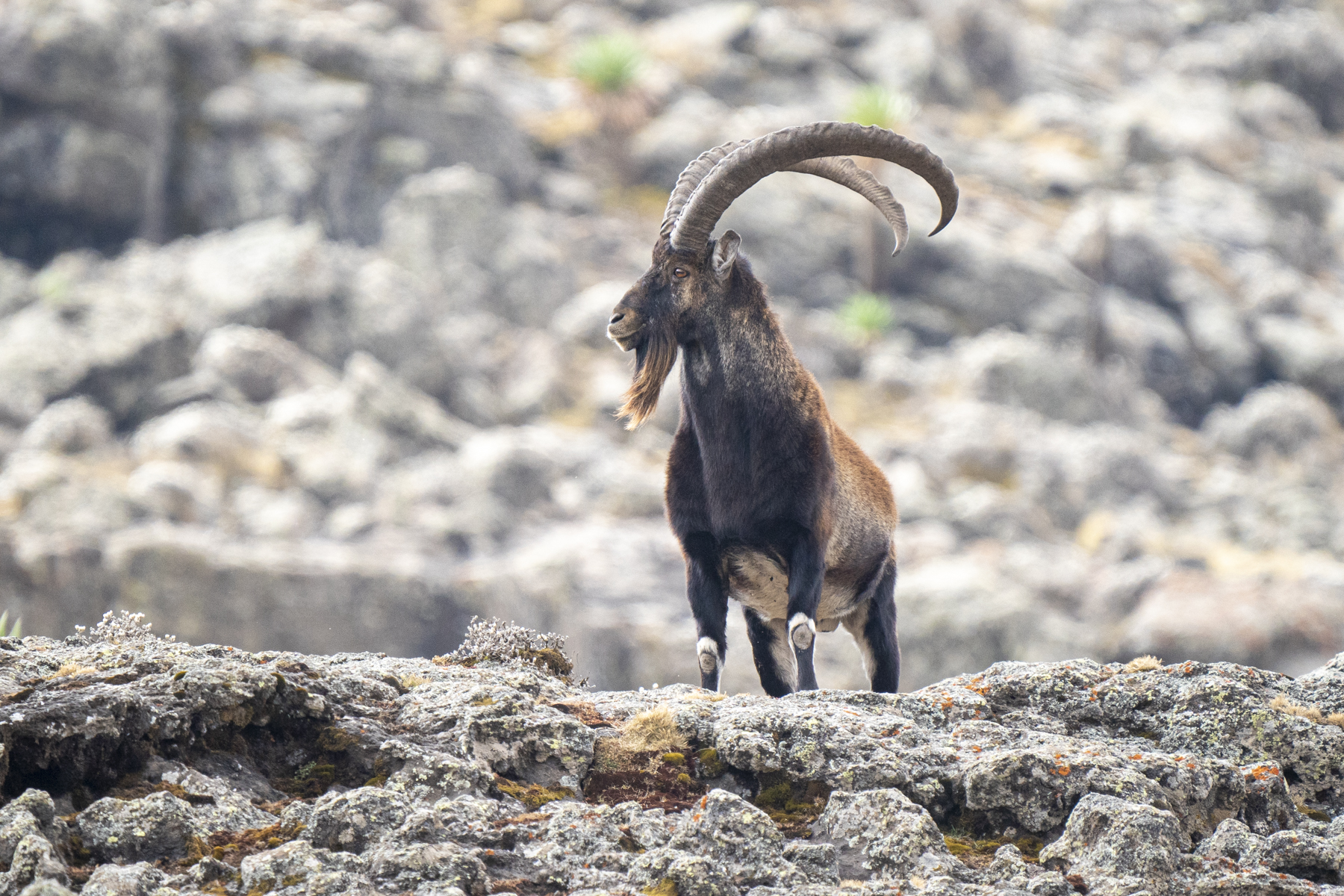
Wahlia Ibex (image by Mark Beaman)

I'm the King of the Castle... (image by Mark Beaman)

I had better head off before the wife finds out I have been spying on the neighbours... (image by Mark Beaman)

Vast panoramas are what the wild Bale Mountains are all about (image by Mark Beaman)
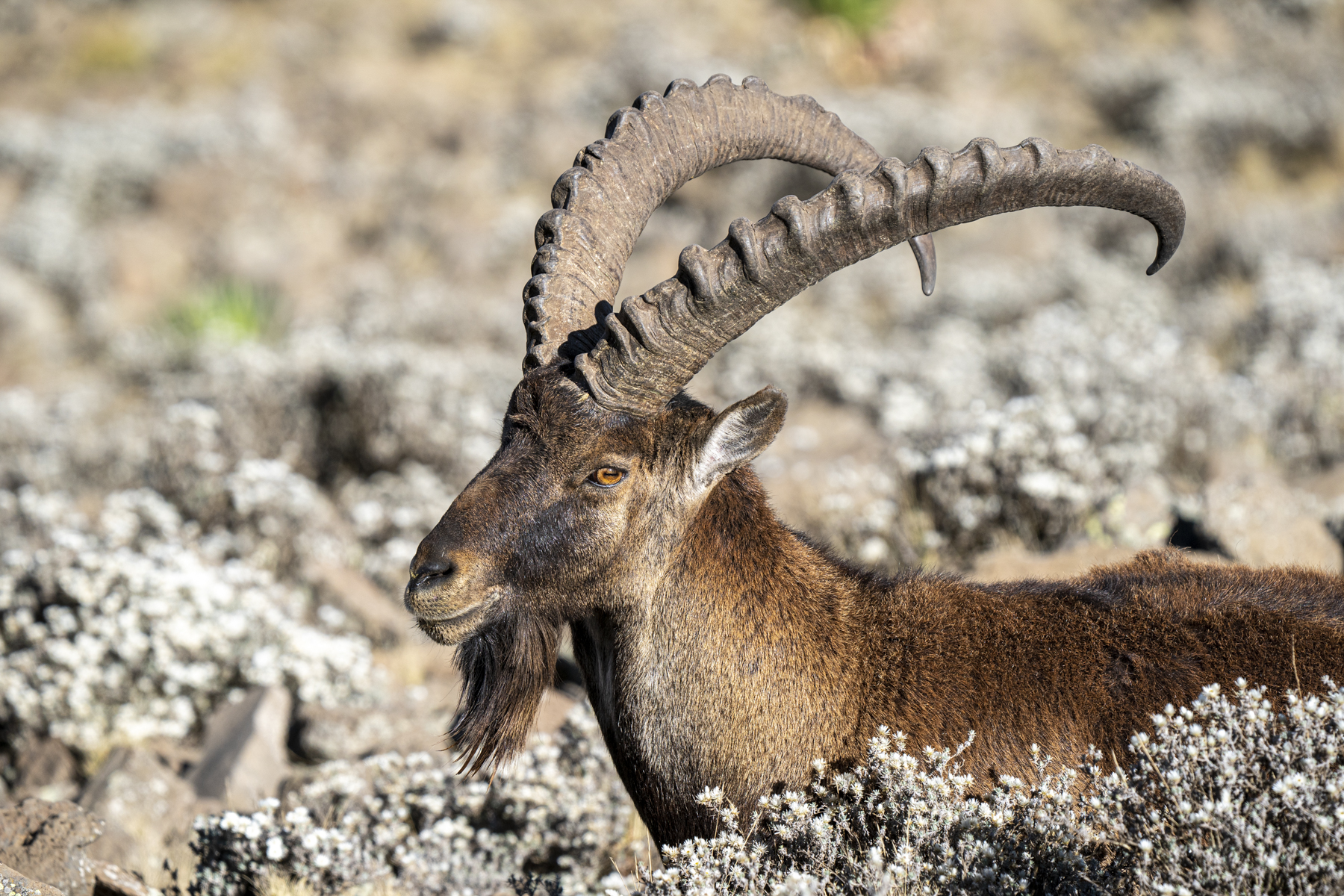
The endangered Wahlia Ibex, endemic to Ethiopia's Simien Mountains (image by Mark Beaman)

The critically endangered, endemic Ethiopian Wolf (image by Mark Beaman)

It must be Gelada love... (image by Mark Beaman)

Simien shepherd boy (image by Mark Beaman)

Mural at Debre Birhan Selassie church in Gondar (image by Mark Beaman)

Guereza Colobus portrait (image by Mark Beaman)

The dramatic landscape of Ethiopia's Simien Mountains, with giant Lobelias in the foreground (image by Mark Beaman)

An Ethiopian Wolf eating a Blick's Grass Rat (image by Mark Beaman)

Thick-billed Ravens often soar out over the precipitous Simien escarpment of Ethiopia (image by Mark Beaman)

Gondar passageways (image by Mark Beaman)

Harar girl (image by Mark Beaman)

No you can't join our gang... (image by Mark Beaman)

The endangered Swayne's Hartebeest, one of the rarest African mammals (image by Mark Beaman)

The cryptic Lichtenstein's Sandgrouse is hard to spot until one is close (image by Mark Beaman)

Nile Crocodile (image by Mark Beaman)

The endemic Black-winged Lovebird (image by Mark Beaman)

Spotted Hyenas sniff the ground, scenting their last feast from the Hyena Men of Harar (image by Mark Beaman)
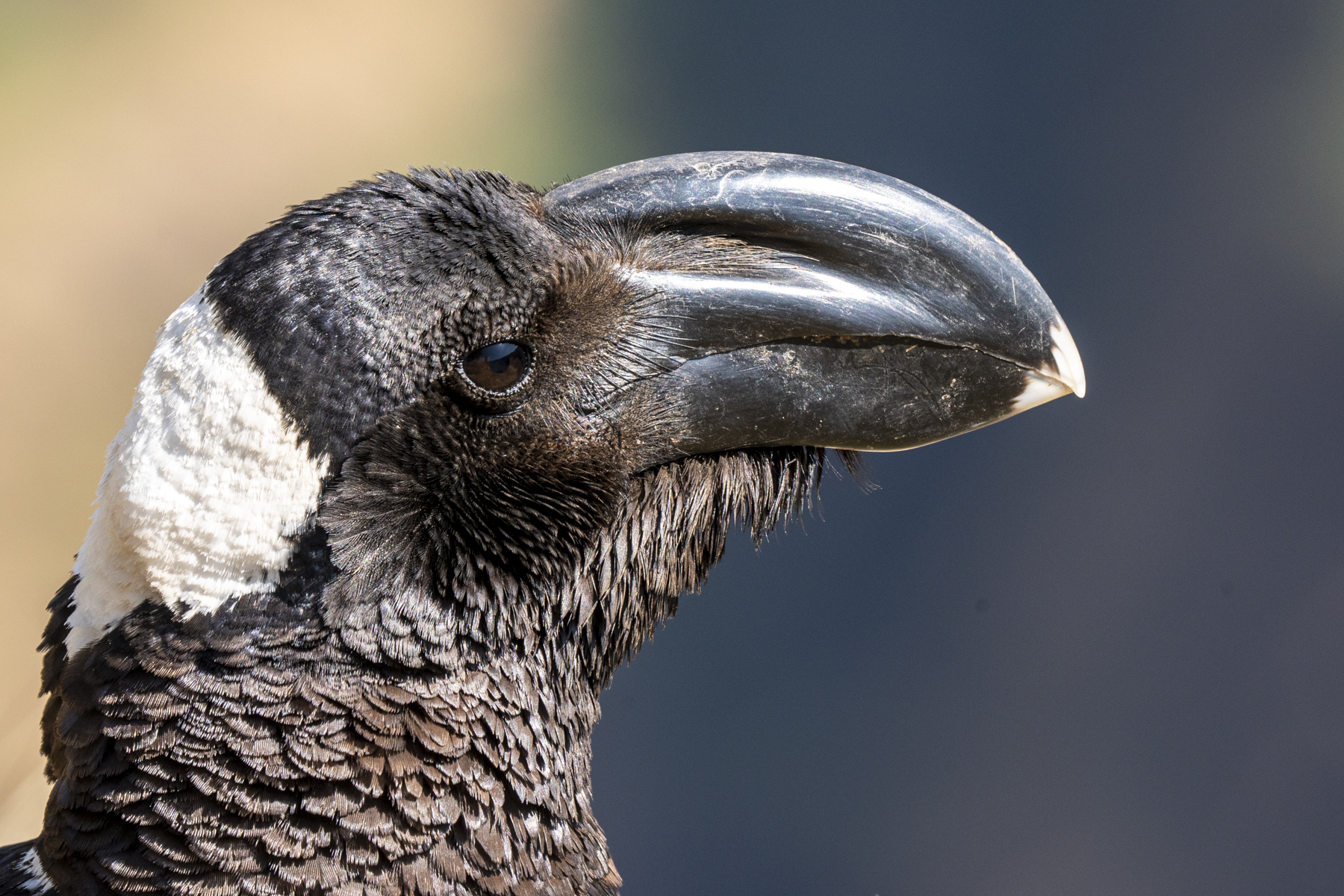
Thick-billed Raven portrait (image by Mark Beaman)

Spot-breasted Lapwing (image by Mark Beaman)

Geladas gathering at the cliff-top at sunset, before climbing down to their sleeping places (image by Mark Beaman)

Spotted Hyenas waiting for their opportunity (image by Mark Beaman)

Harar spice market (image by Mark Beaman)

A Gelada male surveys the terrain ahead (image by Mark Beaman)

Blue-winged Geese in the Bale Mountains (image by Mark Beaman)

Spotted Hyenas enjoying the feast put out for them by the 'Hyena Men' of Harar (image by Mark Beaman)

Blue-winged Geese in the Bale Mountains (image by Mark Beaman)

Great White Pelicans at Lake Ziway, Ethiopia (image by Mark Beaman)

Marabou Storks watch a thrown fish falling towards them (image by Mark Beaman)

Just part of the great castle complex at the ancient city of Gondar, Ethiopia (image by Mark Beaman)

Gelada babies love to play (image by Mark Beaman)

Dried chillies at Harar (image by Mark Beaman)

A Thick-billed Raven lets me know what it thinks of me (image by Mark Beaman)

Somali women at a camel market in eastern Ethiopia (image by Mark Beaman)

Spot-breasted Lapwing, one of the smartest of the Ethiopian Highlands' endemic birds (image by Mark Beaman)

Bohor Reedbuck (image by Mark Beaman)

Hamadryas or Sacred Baboons crossing the road (image by Mark Beaman)

I don't really care where he goes, as long as he scares up some insects... (image by Mark Beaman)

Black Crake (image by Mark Beaman)

An Ethiopian Wolf eating a Blick's Grass Rat (image by Mark Beaman)

Gelada youngster at sunset (image by Mark Beaman)

Grumpy Old Men are not restricted to humans. A male Hamadryas or Sacred Baboon in eastern Ethiopia (image by Mark Beaman)

Our remote camp in the Bale Mountains (image by Mark Beaman)

Dark Chanting Goshawk (image by Mark Beaman)

Harar girl (image by Mark Beaman)

Gelada mother and baby (image by Mark Beaman)

I'm sure I can find another flea... (image by Mark Beaman)

The 'Kite Man' of Harrar, with friend (image by Mark Beaman)

Lanner Falcon (image by Mark Beaman)

The 17th century castle of Emperor Fasilides at Gondar, one of the greatest buildings in subSaharan Africa at the time (image by Mark Beaman)

Gelada close-up (image by Mark Beaman)

Gelada mothers and babies (image by Mark Beaman)

Abbas, the most famous 'Hyena Man' of Harar, with friend (image by Mark Beaman)

The rather 'goofy' Giant Mole Rat (or Giant Root Rat), favourite food of the Ethiopian Wolf (image by Mark Beaman)

Mural at Debre Birhan Selassie church in Gondar (image by Mark Beaman)

The tiny Malachite Kingfisher is like avian jewellery (image by Mark Beaman)

A camel market in eastern Ethiopia (image by Mark Beaman)

Awash Falls, Ethiopia (image by Mark Beaman)

Yellow-billed Kites over Harar, Ethiopia; the one at the lower left got the piece of meat! (image by Mark Beaman)
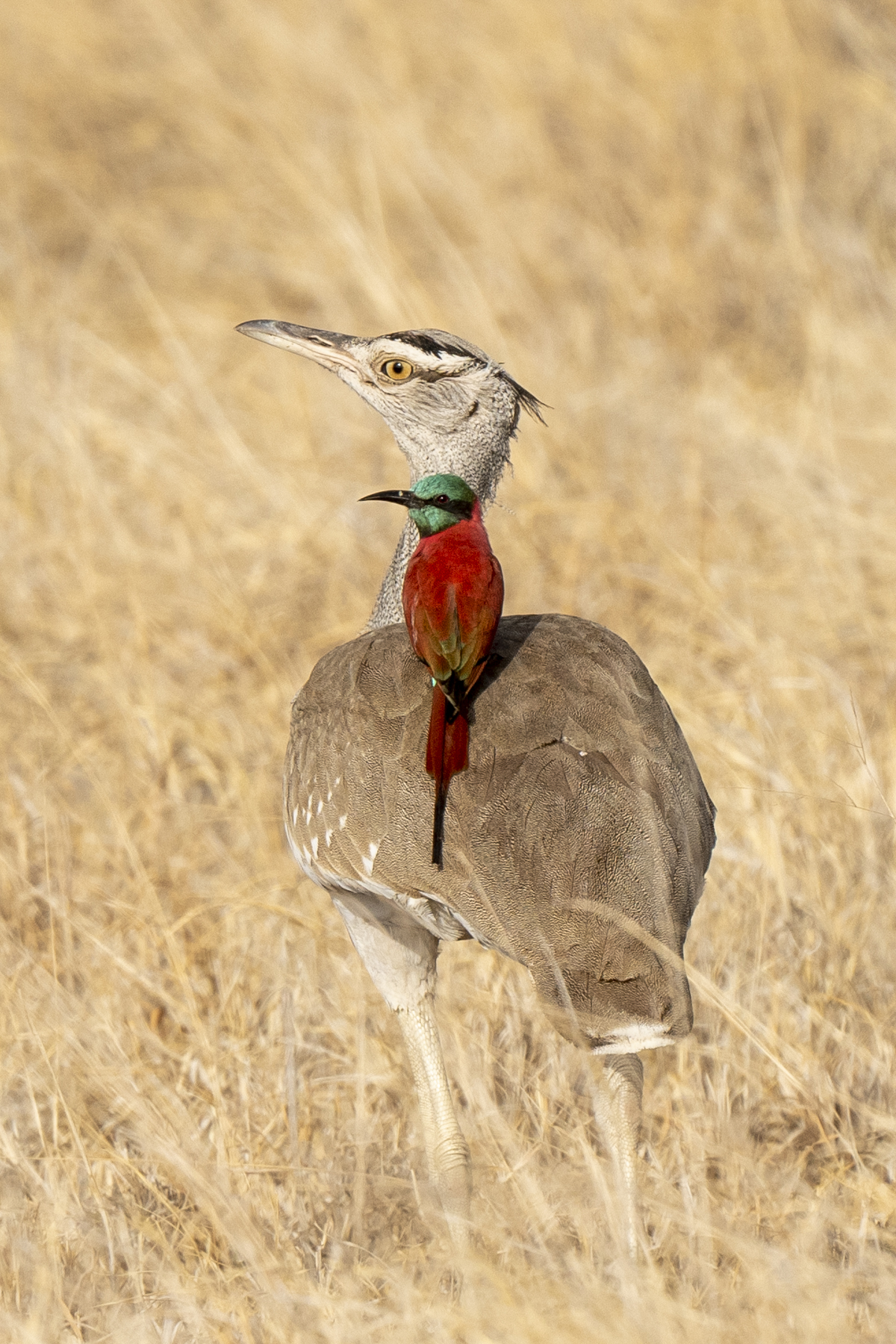
Photographing a Northern Carmine Bee-eater riding on an Arabian Bustard's back is a 'Holy Grail' of African bird photography... (image by Mark Beaman)
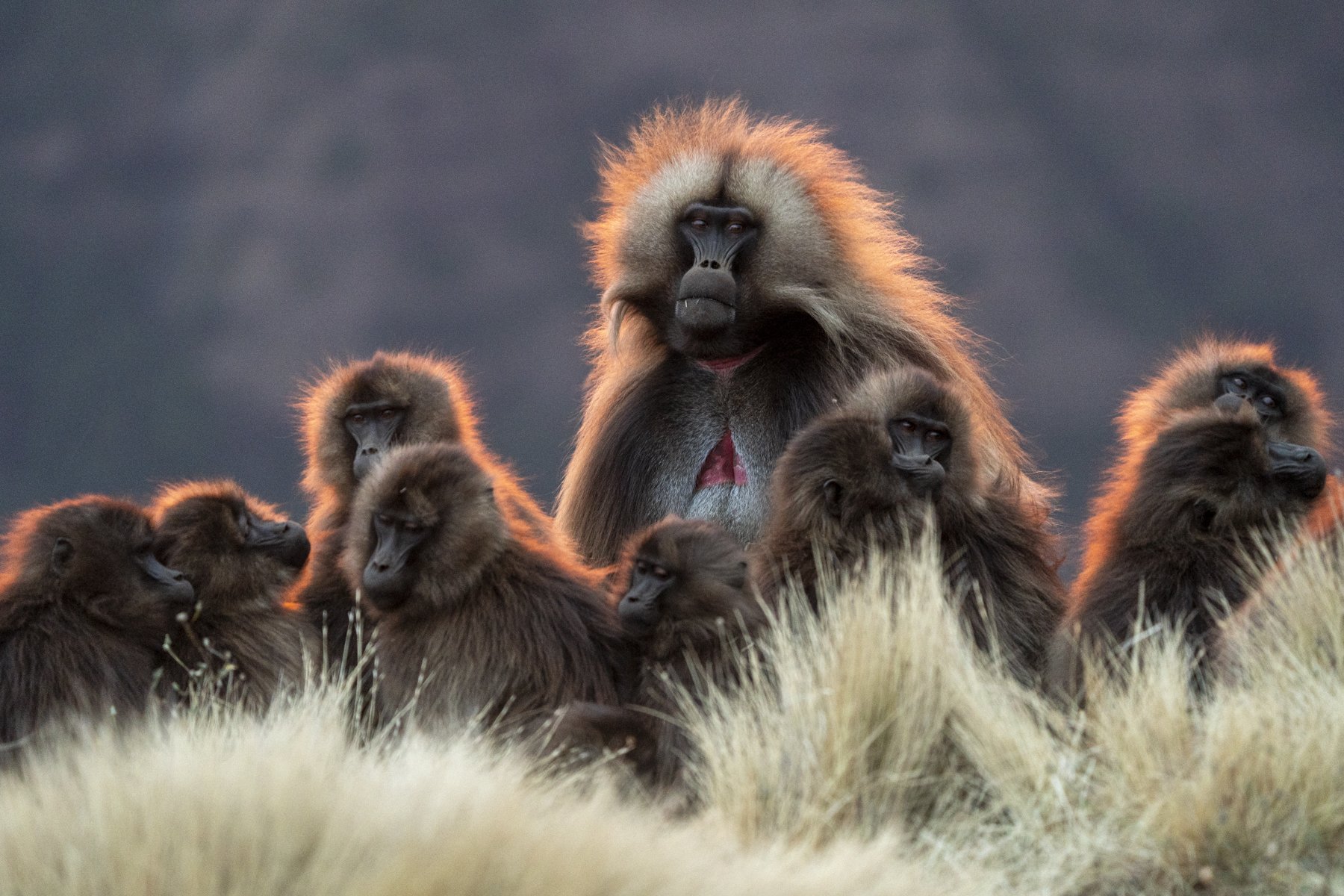
I am the monarch of all I survey! A Gelada family at sunset (image by Mark Beaman)

Augur Buzzard (image by Mark Beaman)

The endemic Thick-billed Raven is an impressive bird of the Ethiopian highlands (image by Mark Beaman)

The dominant Spotted Hyenas at Harar get first pick, while the subservient ones look on like waiting ghouls (image by Mark Beaman)

I want the best spot! Great White Pelicans at Awassa (image by Mark Beaman)
We started off our Ethiopia’s Extraordinary Wildlife 2020 expedition at Addis Ababa, but soon enough we were riding in our 4×4 Landcruisers out of this huge, ever-growing city and heading downslope into Africa’s Great Rift Valley, a huge crack in the earth’s surface that, amazingly, extends from southern Turkey all the way to southern Africa!
We made a short stop at Lake Cheleleka at Bishoftu, but the light was already harsh and there was not a lot going on, so we continued to Lake Ziway and checked into our pleasant lakeside hotel. By the time we finished a late lunch the light was improving and so it was time to explore the lake edge. Flocks of White-faced Whistling Ducks, some bathing and scattering water droplets, made for a good subject and we also came across our first Great White Pelicans, a smart Malachite Kingfisher, Glossy Ibises and in particular a rather sad horse, with a few open sores, that had attracted the attention of a flock of Red-billed Oxpeckers.
By taking a boat out onto the lake, we were able to get pretty close to large flocks of Great White Pelicans and we enjoyed watching them preening or flying past. Many Whiskered Terns and a few White-winged Terns followed us and numbers of Great Cormorants joined the pelicans. African Fish Eagle encounters were frustrating, however, with only distant action and a nice close pair spoiled by the many branches. Such is life…
Next morning we were up early to head for Lake Langano, not a waterbird paradise but instead a large body of deep water with rocky cliffs and escarpments surrounding it. Owls and nightjars were on the menu here, but the sudden sighting of a Tawny Eagle right in the road (eating carrion) had us screeching to a halt and piling out, lenses at the ready. The eagle was remarkably unafraid and was soon joined by its mate, making for some wonderful studies. Eventually, a pack of feral dogs (this was rural Ethiopia after all, not some game reserve wilds) drove them off and we continued onwards to the lake. Well, not immediately as one of those stunning Lilac-breasted Rollers proved distracting.
Down at the lakeside, our keen local guide soon located a pair of Spotted Eagle-Owls for us, after which it was time to head for the cliffs via some extraordinarily cryptic Slender-tailed Nightjars that totally blended in with the twigs and leaf litter in which they were roosting. Over at the escarpment, a huge Verreaux’s Eagle-Owl with bright pink eyelids was the star of the show, although the young Dark Chanting Goshawk that came to call on it and the Wahlberg’s Eagle that dive-bombed it were bonuses.
Before we left the area, more bird subjects came our way in the form of smart Amethyst Starlings, Orange-bellied Parrots, displaying White-bellied Go-away Birds and plenty more.
Shashamene, the largest town in the area, was packed with people (there are over 100 million souls in Ethiopia!), but it could produce a good lunch. You don’t go to Ethiopia for fine cuisine, that’s for sure, but for its amazing and often unique and very approachable animals.
Our last port of call was the Senkelle Wildlife Sanctuary, last haunt of the endangered Swayne’s Hartebeest. This antelope, which is now reduced to just two significant surviving populations, is named after a British officer of the days of empire. I like to think he carefully studied the newly-discovered creature before polishing off just a couple for the Natural History Museum to establish the new taxon, but perhaps he killed dozens and stood on the pile of carcasses wearing a solar topee and holding his rifle for a celebratory photograph. I will likely never know.
Anyway, after negotiating a narrow dirt track, complete with domed ‘tukul’ huts, goats, kids, farmers and even a heap of vultures, we eventually came to the beautiful natural grasslands, scattered with flat-topped acacias, that make up Senkelle. Swayne’s Hartebeests were common enough and let us get pretty close, while there were also plenty of dainty Oribis and a number of Common Warthogs, including a mother with a collection of piglets. Montagu’s Harriers hunted low over the grassland and a close Great Spotted Cuckoo provided the last avian subject of the day.
Arriving at our Awassa hotel was a bit of a contrast from Ziway, with half the rooms lacking hot water and a dimly lit restaurant with friendly but inattentive waiters. Such are the contrasts one must expect when exploring ‘Planet Ethiopia’. The country is so scenic, so friendly, but, like ‘Bones’ might have said when talking to Captain Kirk on Star Trek (I am betraying my age here) ‘it’s tourism Jim, but not as we know it…’
Frustrations were soon forgotten, however, when we walked along the shoreline of the eponymous lake and encountered lots of photogenic birds, notably including an African Fish Eagle that put on a great aerial display as it uttered that yodelling cry that is so evocative of Africa. Perky little Black Crakes were everywhere and we enjoyed photographing the dainty African Pygmy Geese and even a rare Allen’s Gallinule.
Back in the hotel grounds, handsome, black and white Guereza Colobus monkeys had gathered near the restaurant for breakfast and we enjoyed watching them interact with each other and sometimes descend from the trees to grab a tidbit. Naughty little Grivet Monkeys added to the simian gathering.
Before we left for the Bale Mountains, we visited the busy fish market beside Lake Awassa. Fish sales were in full swing by the time we arrived and, as well as the human visitors, there were aggregations of Marabou Storks, Great White Pelicans and White-breasted Cormorants, all looking for handouts. Of course, it is all a bit contrived, but getting fish thrown to the birds makes for some exciting images as they interact.
The giants at the party are the Marabou Storks, with wingspans around 3 metres (10 feet)! These rather ugly birds are surprisingly nimble when it comes to leaping into the air to intercept a falling fish. While the storks stay on land, or, at most, visit the shallows, the pelicans stay on the lake but will come close when tempted. Feeding the pelicans resulted in some great low-level shots as they squabbled, often distending their bill pouches in extraordinary fashion, while around them the faster-moving cormorants were ever on the lookout for a stray tidbit.
From Awassa we headed uphill into the Bale Mountains, stopping along the way to ‘admire’ a deadly swarm of locusts migrating across a mountain pass in order to devastate some more poor farmers’ crops. Eventually, we reached the park headquarters at Dinsho and checked in. From there it was off the tar and onto the dirt tracks for our ascent onto the high plateau of the Bale. One of now-regular rabies and distemper outbreaks had been causing severe Ethiopian Wolf mortality in the Sanetti Plateau area before our visit, so we had arranged to spend part of the time camping in an unaffected area. This proved a very good decision, but our good fortune was not entirely obvious to us when we arrived at the camp to find our camp crew were short of a tent and our first night’s dinner was outside in the montane drizzle… (Fortunately, they had a new tent shipped in next day.)
I had been worrying about the decline of the Critically Endangered Ethiopian Wolf and the news of yet another outbreak of disease just seemed like another disaster for this wonderful creature, but luckily the area we were in had not been affected and wolves were still common. We had multiple sightings every day, although mountain heat shimmer was an issue in early encounters so we had to be patient until the right moment came. And come it did, with an absolutely fabulous hour-and-a-half session with an extremely approachable wolf that hunted Giant Mole Rats and Blick’s Grass Rats right beside our vehicles. No shimmer now and the ‘burstometer’ well into the red zone… We watched it stalking, pouncing, sniffing, digging, munching on grass rats, calling and indeed doing everything Ethiopian Wolves typically get up to.
Although we had so many great wolf encounters, Bale is not just about wolves. For a start, the Afro-alpine scenery, complete with Giant Lobelias in places, is extraordinarily wild, and the Ethiopian horsemen we encountered riding across the moorlands just added to the Tolkienesque feeling about the place.
Endemic Blue-winged Geese and Wattled Ibises were all over and endemic Spot-breasted Lapwings common and unusually approachable. Rock Hyraxes, a Cape Eagle Owl, numerous Steppe Eagles and Augur Buzzards, shy African Snipe and river-loving African Black Ducks all added to the diversity. And of course, no photography safari to Bale would be complete without the stalking of the buck-toothed Giant Mole Rat! So you think a Serval or a Wild Cat is shy? Try even looking at a mole rat, let alone stepping one step closer… down its hole it goes!
Our time in the Bale ended with a fond farewell to our wonderful camp crew and a welcome shower and a real bed in Goba, as well as a chance to explore the Dinsho area and the Sanetti Plateau. At Dinsho the endemic Mountain Nyalas were unusually approachable, providing some great images, and even the Bohor Reedbucks performed, although the endemic Melelik’s Bushbucks were more skittish. For those who love birds, the rare endemic Abyssinian Owl we were taken to, at a day roost, was a highlight.
Our last morning on the Sanetti yielded more great encounters with Ethiopian Wolves, yet more Giant Mole Rats, Ruddy Shelducks and of course yet more awesome scenery. Oh, and I forgot to mention those bold Rouget’s Rails and the francolins, the Stark’s Hares (is winter coming?) and everything else… What a fantastic place Bale is. We were all sorry to leave the area and descend into the Great Rift Valley to Awassa.
After more colobus and grivet encounters it was time to return to Addis. A lakeside stop en route only produced rather unsatisfactory (from a photographic viewpoint) encounters with beautiful Common, Wattled and Black Crowned Cranes. By the evening we were flying over Lake Tana, the source of the Blue Nile, before landing at Gondar, the ancient capital of the Ethiopian Empire.
Next morning saw us exploring the ‘Royal Compound’ at Gondar, where the castles and palaces of many of Ethiopia’s greatest Emperors and Empresses are to be found. This extensive complex has a decidedly ‘Camelot-like’ feel to it, even as regards the architecture, and the extraordinary fortress-palaces were once the tallest buildings in subSaharan Africa. However, Camelot it was not as many of the royal successions involved parricide, fratricide, imprisonment or revolt, or any combination thereof.
After taking a look at the extraordinary murals of the Debre Birhan Selassie church (reputedly saved from destruction by the invading Dervishes by a swarm of bees), one of which features St George slaying the dragon, it was time to head for the Simien Mountains. We arrived at Simien Lodge just in time to put our things in our rooms and get outside as rapidly as we could to follow a huge herd of Gelada monkeys that had invaded the lodge grounds. (Geladas are baboons no longer, following taxonomic reassessment.)
It was fun watching them peering in through the bedroom windows. What took their interest I wonder? As they moved off, so we followed. As always with the Geladas, they are gentle enough with each other, at least most of the time (the occasional fight is more a noisy chase, complete with bared teeth and gums, than a real battle). As far as humans are concerned, in areas like Simien where they are not molested, Geladas are remarkably tolerant and if you crawl slowly you can get right up to them. So we all did, repeatedly. After a time, sunset approached and the herd headed off for the Simien escarpment cliffs where they would be safe from marauding leopards during the night.
Over the next few days, we had several more Gelada sessions, including an absolutely fabulous encounter with around 400 in the late afternoon. After doing all the usual things – feeding, drinking, playing, grooming, mating, mock-fighting and the like, the herd started to move off en-masse and head for the nearby cliffs. We were able to follow them right to the edge and obtained numerous backlit images in the wonderful orange-red light as the sun set on the awe-inspiring Simien scene. Wow! Wildlife photography does not come better than this.
Geladas are endemic to the northern highlands of Ethiopia, but the magnificent and Critically Endangered Wahlia Ibex is nowadays almost entirely restricted to the Simien, where only about 400 survive. We headed off early to Chenek to look for them and we struck gold on our first attempt, coming across a number of splendid males along with females and youngsters. They were very tolerant of us and indeed went to sleep right in front of us. It was only on the second attempt, however, that we managed to take photos of males on the skyline.
Thick-billed Ravens are widespread endemic birds of Ethiopia and Eritrea, but in the Simien they really come into their own, soaring over every precipitous crag. They are very garrulous and enjoy interacting with their peers, making for great photography. Bearded Vultures (or Lammergeiers) also performed, as did a very obliging Lanner Falcon. On our last morning, we visited a spectacular valley where we could photograph Rüppell’s Vultures and Augur Buzzards from above as they left their roosting places far below and soared upwards before heading off to feed.
From Simien, we returned to Addis and the end of the main tour, but for those taking the Awash and Harar extension, a new adventure was about to begin.
First, we descended into the Great Rift Valley, with the temperature climbing steadily, but this time we continued eastwards into increasingly arid landscapes, punctuated by volcanic hills. Eventually, we reached Awash Falls in the midst of Awash National Park, a welcome oasis by the Awash River. Our lodge overlooked the falls, which are definitely impressive, and below them we found a series of large Nile Crocodiles. Some were basking on the beach or on rocks, but others were ‘surfing’ in the rough water immediately below the thunderous deluge, apparently hoping to encounter fish swept over the falls.
Awash National Park offers some good bird photography, but mammals here are sparse and shy, generally heading off as soon as a vehicle approaches. Poaching in this part of Ethiopia is an ever-present issue. With just one night in the park, largely in order to break the journey to Bilen, we had little time here, but the beautiful Rosy-patched Bushshrikes performed well and we had really wonderful encounters with ultra-close Lichtenstein’s Sandgrouse, even while on foot. (One nice thing about Ethiopia is that you can walk freely in the parks.)
Further into the arid lands of the Awash region, well on the way to the famous Danakil Depression, is the Bilen area. We stayed here at a simple lodge in the Afar lands that is more often utilized by hunters than photographers, but we were the only guests. The friendly staff looked after us well and made up for the simplicity.
Not far away are the grasslands of the huge Ali Deghe reserve, and it was here that we spent most of our time. One of the ‘Holy Grails’ of African wildlife photography is obtaining great images of the stunning Northern Carmine Bee-easter riding on the back of a huge Arabian Bustard. This is by no means easy to achieve, as it does not happen very often, especially when you are willing it to! However, we struck lucky on our first morning, finding no fewer than three bustards with their little riding friends. A lot of shots later and we were all confident we had the grail in our grasp.
Soemmereing’s Gazelles and Beisa Oryx proved harder to photograph, not least because of the heat shimmer that is an issue in so many parts of Africa between about 9 and 4, or even 8 and 5 round here! Eventually, we managed it, but don’t ask about the Grevy’s Zebras… A close Secretarybird, patrolling Montagu’s and Pallid Harriers, Somali Fiscals, lumbering bustards in flight and other subjects livened up our stay.
From Bilen, we set out for our ultimate goal, the remote city of Harar in the highlands of eastern Ethiopia. It was a slow journey, thanks to the many trucks, but eventually, we reached the city and, thanks to Inger (who had arrived a day earlier), avoided ‘a fate worse than death’ by changing hotels. Her choice proved a pleasant one, and we all enjoyed the outdoor restaurant.
Before turning our attention to Harar itself, we headed further east to a camel market that attracts Harari and Somali people from far and wide, even from Somaliland. It was fun to experience the market and see and photograph the buying and selling, the colourful crowds of chattering women, the little boys carrying water jugs, the men with henna-dyed beards, the wooden camel bells and all the rest. And I almost forgot to mention those Hamadryas (or Sacred) Baboonbs we came across just before the market. Talk about ‘Grumpy Old Men’; that description fitted some of them perfectly.
Harar is one of those truly fascinating towns where the medieval character lingers. The narrow stone alleys, the ancient houses with their doorways and balconies, the colourful Harari womenfolk (not always shy of photography, mercifully), the skull-capped menfolk, the crowded spice market, the hustle and bustle – it was all fascinating and highly photogenic.
For wildlife photographers, however, the two things that are big draws are the ‘Kite Men’ and the ‘Hyena Men’ of Harar.
Down at the butchers quarter, we soon had one of the ‘Kite Men’ holding out, or throwing up in the air, little meaty tidbits for our feathered friends. They feed them regardless of whether there are visitors around who are willing to pay, so even as we arrived there were rows of beady-eyed kites waiting on the roofs! Once they spot food they are soon swooping down to get to the morsel first, or having aerial squabbles over pieces thrown upwards. Amazingly the Kite Man never seemed to get a talon in his hand, in spite of the kites’ daredevil antics.
The Kite Men are fun, but what Harar is really famous for is its Hyena Men. Long ago, special low doorways were built into the city walls of Harar so that Spotted Hyenas could enter the city at night and clean up offal and scraps – an early understanding of the need for better hygiene. Eventually, the hyenas were lured to the city with food.
More recently the custom died out, but a generation back the fathers of the current Hyena Men restarted the custom. Word spread and now they get a regular flow of visitors wanting to see them in action. We had a couple of evening sessions with Abbas, a leading Hyena Man, and it was a real highlight of the tour. Soon after dark the hyenas start to emerge from the gloom at the city’s edge. They were not at all aggressive and waited patiently for Abbas to start feeding them, alongside a few feral dogs.
All the Hyena Men are natural showmen, so after feeding them with a stick by hand, and then by mouth, he started inviting the audience up to do the same. Well, having a bloody great Spotted Hyena resting on your shoulders like an unusually coarse-haired Saint Bernard dog, and just as heavy, and then seeing its huge toothy muzzle eating a piece of meat just inches from one’s face, now that is ‘an experience of a lifetime!’
For we photographers, it was a wonderful time. We shot Abbas and his friends, our companions and their hyena pals, lone hyenas, groups of hyenas, hyenas lurking in the gloom, hyenas standing right over us (you could get down on your belly with them if you dared) and hyenas en masse (we had up to 20 or more present at times). Sadly no one was eaten. Sorry, just a joke…
We had seen and photographed so much on our Ethiopian adventure, and this final icing completed a wondrous cake of rich experiences.



















































































































